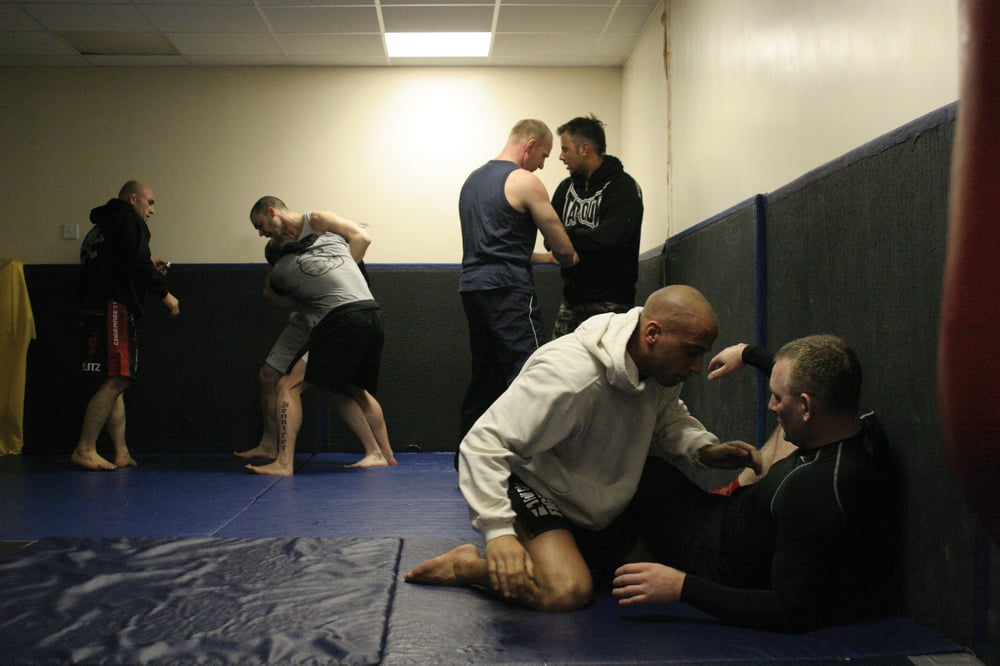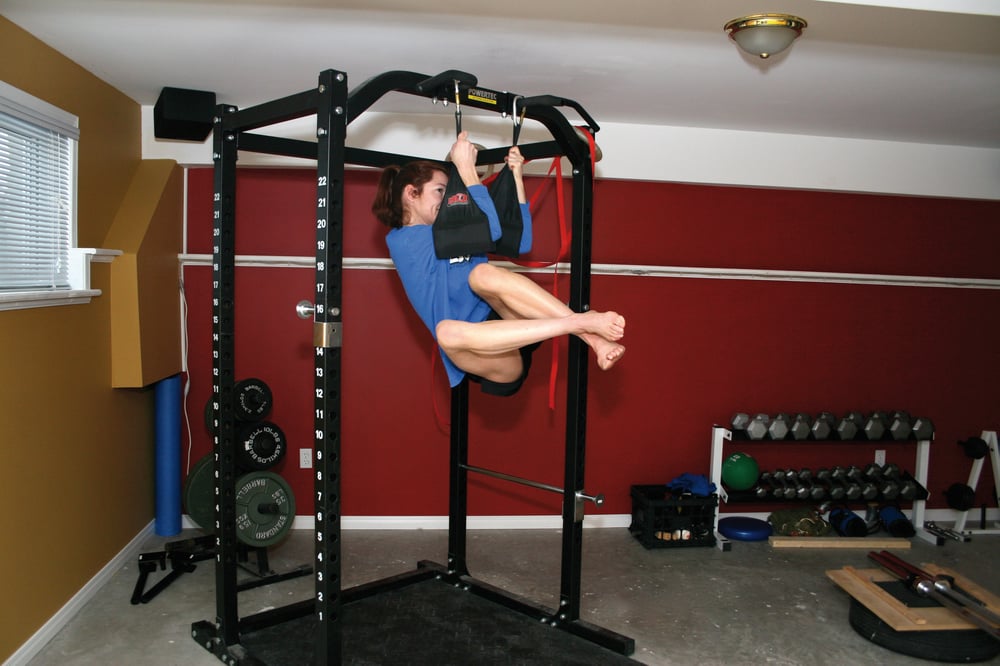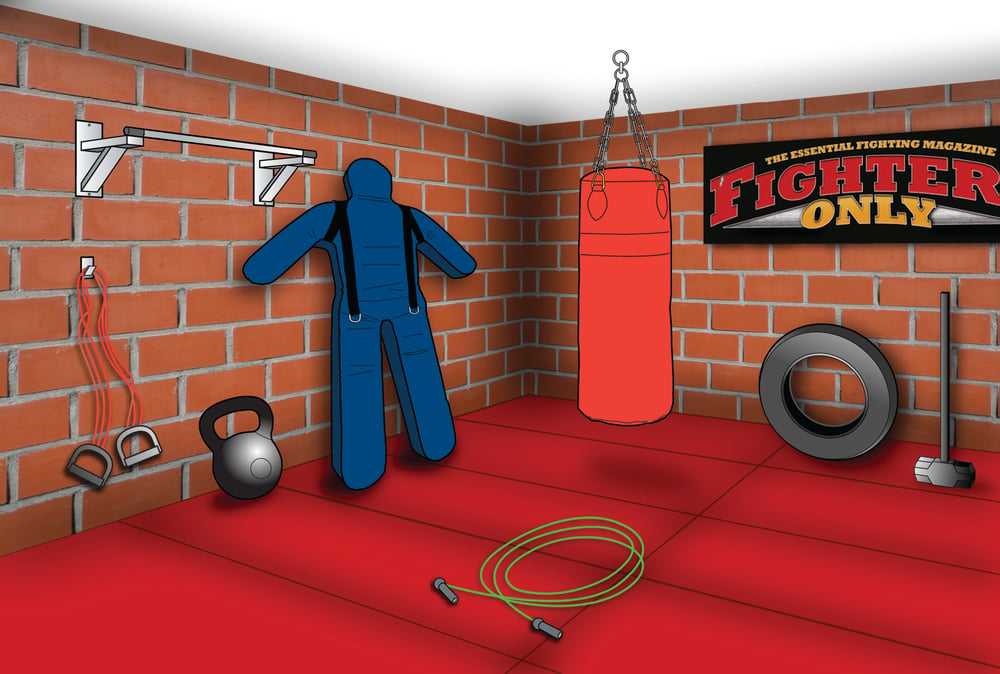
Issue 048
April 2009
A Guide to Building the Ultimate Home Gym
Until recently home gyms were seen as a luxury few could afford. Unless you had a spare room in your ‘Cribs’-style mansion, or a purpose-built building on the grounds of your sprawling country estate, creating somewhere to train in the comfort of your own home seemed like a pipe dream.
How things change. We’re in a new millennium, and with the credit crunch tightening purse strings across the country, home gyms aren’t just desirable: in some cases, they’re proving to be more appealing than the traditional alternatives.
In the movie Fight Club, Tyler Durden asks two of his ‘Project Mayhem’ acolytes, “Guys, what would you wish you’d done before you died?” “Paint a self-portrait,” answers one. “Build a house” says the other.
If you were to create a list of goals you’d like to achieve before it’s too late, what would it consist of? For some it might be simple, much like the above. One thing that seems to crop up time and time again among mixed martial artists though, is “build a home gym”.
The appeal of having your own personal training facility is hard to beat. Whereas men of a certain ilk had a study, a den, or even a shed in which to lock themselves away from the world, those of the MMA generation would prefer their refuge to be a place where they can also develop their MMA skills and physical fitness.
If the idea of having a home gym seems a bit strange to you, consider the fact that some of the world’s top fighters came from humble beginnings. Rorion Gracie taught Brazilian jiu-jitsu [BJJ] out of his garage in the 1980s, steadily building up his reputation until he was able to open his own school.
MMA fighter John Lober, who famously smashed Frank Shamrock in the late ‘90s, trained out of his LA garage, even offering people money to come and spar with him. It was in this garage gym that people such as ‘Skyscrape’ from TapouT got their first taste of mixed martial arts.
Creating your perfect home gym isn’t particularly difficult, but it will take time, money, and some space in your house. Most people opt to use their garage or basement, and there are pros and cons to each. It can be as simple as clearing out some space from your garage, or as complicated as a long-term DIY project. The beauty of a home gym is that you can tailor it exactly to your wants and needs.
Fighters Only’s resident strength and conditioning expert, Alex Gold, has a fully kitted-out gym at his house in London. “I cleared out the garage of all the crap that was in there,” he says. “I’ve got a power rack, 450kg of weights, dumb-bell handles, kettlebells, a heavy bag… Why do I train there instead of a fitness gym? To get away from all the idiots, mostly!”
Though more tailored to pure strength and conditioning, Alex’s home gym is a perfect example of what is possible with a little bit of space. His double garage has been taken over by the various pieces of equipment he uses, but he advises keeping it as simple as possible. “You don’t need a great deal of equipment, all you need is a sensible plan and some motivation, and off you go.”
Daniel Swan, a student at Loughborough University who trains MMA with nearby Leicester Shootfighters, created his garage gym out of necessity. Originally from Swansea in South Wales, the poor transport links meant he couldn’t attend regular sessions at the local club. “Where I lived, if you haven’t got a car you can’t get around anywhere. I needed somewhere to train regularly, and on weekends I would travel up to Swansea to train BJJ.
“I’d work striking on the bag, and I had a few mats down. I’d get mates over and we’d do some grappling and go through a few techniques. We’d use things from YouTube, Eddie Bravo’s books, Renzo Gracie’s stuff, go through the basics and drill things.”
Dan’s gym is a modest affair, stripped down to the bare essentials. With a bag, pads, some mats and a small collection of free weights, he says the hardest thing to find is a reliable training partner. “As long as you’ve got a willing training partner and some space, that’s all you need. That and the right people to learn from – that’s the power of YouTube! The most difficult aspect of it all is finding a regular training partner who doesn’t lose motivation.”
Due to his limited budget, Dan had to work hard to overcome the challenges of training in such a limited space, but managed to find a novel solution that cost him nothing at all. “We needed somewhere soft where we could do takedowns, and that’s where the mats didn’t work, because they were only yoga mats and they were on a concrete floor. We couldn’t afford judo mats, so as I lived near the coast we’d go there and drill a lot of grappling on the beach!”
Pros and Cons of Having a Home Gym
Freedom
Alex: “I did a deadlift workout at one o’clock in the morning one Christmas. I don’t think that’s something you can get away with at a fitness gym!” The luxury of deciding when and how you train is something that appeals to many, including those who can’t travel or make certain class times.
Saves Money
Mat fees can add up when you’re training at a club a number of times a week, and fitness gyms often have costly monthly membership fees. Once you’ve made the initial outlay on kitting the place out, you’ll never have to pay for training again.
Lack of training partners
You might be the kind of guy who prefers to train alone, and if this is the case then a home gym is probably perfect for you, but some people just can’t get motivated unless someone is screaming and shouting at them. “I think you have to be the right kind of person to train by yourself. Lots of people want other people to push them. It’s a certain kind of person who can motivate themself,” says Alex.
Space
You might be able to clear
out that spare room, basement, or garage, but sometimes you just haven’t got the room to be able to do what you want to do. Everything from low ceilings to not enough floor space can limit your options.
Do what you want
Want to work out until you pass out, drop to the floor in a pool of sweat and puke everywhere? These kind of things are generally frowned upon in public. Avoid the snide comments and dirty looks and beast yourself to your heart’s content in the comfort of your own home.
AMATEUR
If you’re the kind of person who prefers simple functionality over polished, state-of-the-art equipment, you’ll probably plump for the amateur gym.
All you’ll need to get started is to requisition a room, clear out the junk (such as children’s furniture, elderly relatives, that sort of thing) and lay down a few mats. The beauty of training MMA is that most of the stuff you do requires very little equipment. All your technique work and drilling simply requires a willing body.
For fitness and conditioning, body-weight exercises can provide a challenging workout. If you don’t believe us, check out one of Barry’s articles in the Performance section, he’ll gladly prove you wrong!
A few small items of equipment can make things interesting though. Kettlebells and medicine balls don’t take up a lot of room but can be used in a multitude of ways and are especially useful for anyone who trains in combat sports. An exercise ball is great for body-weight exercises and mobility work, and in a pinch can even substitute for a body during ground ‘n pound drills.
A punch bag is useful but not essential. You’ll need to check your walls or ceiling to see if you can attach the brackets that hold it, but freestanding versions are available as an alternative.
Second-hand mats can often be acquired for far less than brand new ones. Try local free adverts, as schools and gyms often sell off old or slightly damaged mats. With a bit of duct tape and a lot of patience, rips and tears can easily be fixed. If you’re in a pinch and can’t afford proper mats, a few layers of carpet underlay with a vinyl cover, such as a tarpaulin, is a great budget alternative.
TOP TIP
Make time to train
Brazilian jiu-jitsu black belt Mike Sweeney teaches MMA at his gym, Martial Arts Planet, in Kingston, Ontario (www.martialartsplanet.ca), but trains at home in his basement along with his MMA fighter wife Rebecca. The reason? If they don’t train at home, they don’t get to train properly at all. “For us, once we get to work (the gym) your time gets tied up with work stuff. Working out in the morning was the only time we could get it done. The early in the day you can work out, the less chance there is of stuff getting in the way.”
WHAT YOU'LL NEED
Punch Bag from £39.95
Hanging punch bag
www.ko-sports.com
Medicine Ball from £11.99
www.made4fighters.co.uk
Kettlebell from £9.95
Pro-X Kettlebell
www.pro-xsports.com
Skipping Rope £9.79
Classic leather boxer’s rope
www.fightshop.com
Exercise Ball from £17.95
www.made4fighters.co.uk
Mats
From £10.00 + VAT sq. metre www.cannonsuk.com
SEMI-PRO
So you’ve got the space, a bit of spare cash, and the desire to put a gym together that would rival that of your local MMA club. How difficult is it to get everything together to make a fully functional gym in which you and your friends can train? Nowhere near as hard as you might think.
As with the amateur home gym a stripped-down approach is the name of the game, but with some consideration you can turn a makeshift solo-training set-up into a solid centre to make your neighbours jealous.
Start by getting some decent mats and making sure they cover the entire floor space. The wall-to-wall padding will cut down on any accidents and help keep dust and dirt off the mat. Two-inch thick heavy-duty sticky tape can seal the gaps between mats, meaning fingers and toes are at less risk of getting caught.
Add to your list of equipment by getting yourself an old tyre and a sledgehammer. Hitting a tyre for timed rounds is a great exercise, and guaranteed to skyrocket your conditioning. You can even take it outside and flip it about the place – the only limitation is your imagination.
A wall-mounted hook with resistance bands opens up a whole new range of exercises. You can drill takedown movements such as shoots, twisting throws, and more, and even do punch-out drills standing or on the floor.
If you’re stuck for a training partner, consider getting (or even making) a grappling dummy. There are many different types on the market, and they are useful to practice the kind of things you just do to your training partners. Suplexes, ground ‘n pound, repeated slams; a grappling dummy never complains.
The aim with the semi-pro home gym is to create a space where you’re able to train much the same as you would at a gym. An amateur home gym is good for occasional workouts, such as when you can’t make the gym, but the semi-pro version is somewhere you’d feel happy in knowing you can get just as good a workout as anywhere else.
TOP TIP
Just do it
“Doing any workout is better than no workout,” says Mike. “A lot of people say they’re too busy. Maybe you’re too busy to do an hour and half training session, but you can kick your ass with a 20-minute workout. Make a point of scheduling in a workout. Busy people get stuff done because they schedule time for things.”
WHAT YOU'LL NEED
Punch Bag £72.00
40kg Windy punch bag
www.fightshop.com
Pull-up Bar £25.99
www.powertrainer.co.uk
Kettlebell from £9.95
Pro-X Kettlebell
www.pro-xsports.com
Skipping Rope £9.99
Pro speed rope
www.lemarr.com
Sledgehammer £49.95
10kg powerhammer
www.made4fighters.co.uk
Tyre from £111.00
www.agriculturaltyresonline.com
Resistance Bands from £7.95
www.bytomic.com
Dummy £316.66
Tough Guy grappling dummy
www.ultimat.co.uk
Mats
From £16.50/sq. metre www.cannonsuk.com

PROFESSIONAL
Is money no object? Do you want to own a gym that would rival that of the top training centres in the world? Then look no further than the professional home gym.
If you’ve got the cash to spare, why not go all out? For many people, a dream home-gym is more accessible than you might think. Bags and mats, even when bought brand new, are not that expensive, leaving you able to splash out on the luxury items.
If you want to build a professional gym, then matted walls are a necessity. A cheap and easy alternative to a fence, covering a wall with a mat takes up far less space than a cage and is easy to clean and look after.
As mentioned, if you’re on a budget most of your physical training can be done on body-weight, but if you’re going all out, go all out! Sledgehammers, sandbags, dumb-bells, kettlebells. The more equipment you’ve got, the more variety you can add to your training, meaning better results all around.
Music is essential for training, and no gym is complete without a sound system, and what better to watch your instructional videos on but a flat screen TV? Complete the set-up with a fridge (for cold post-training protein shakes) and you’re good to go.
You’ll never struggle to find training partners with a gym like this – in fact, the only problem you may have is getting them to leave!
TOP TIP
Not a complete solution
As nice as it is to be able to train at home, it is still important to get to a session where you’re training with lots of different people. “Training in a home gym would never replace training in a class. It’s a supplement to group workouts,” says Mike. “You need multiple people to train with. If you’re only training with one guy, you get too comfortable with their style. What if you meet someone who is a different size, or right handed?”
WHAT YOU'LL NEED
Punch Bag £129.99
100lb UFC-branded punch bag
www.TKO-sports.co.uk
Pull-up Bar £89
www.taosport.co.uk
Kettlebell from £9.95
Pro-X Kettlebell
www.pro-xsports.com
Skipping Rope £12.71
‘Taurus’ fast rope
www.fightshop.com
Sledgehammer £124.95
25kg powerhammer
www.made4fighters.co.uk
Resistance Bands from £7.95
www.bytomic.com
Dummy £355.44
Grapple Guy grappling dummy
www.ultimat.co.uk
Powerbag from £59.95
www.made4fighters.co.uk
Focusmaster £686.03
Focusmaster wall system
www.pad-up.com
Dumbbells £440.42
Neo Hex dumb bell rack
www.yorkfitness.com
Fight Timer £146.80
www.fightshop.com















